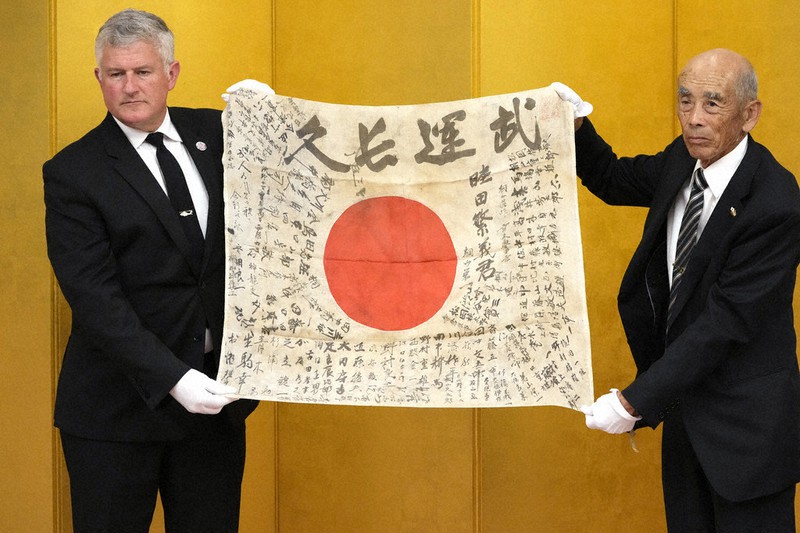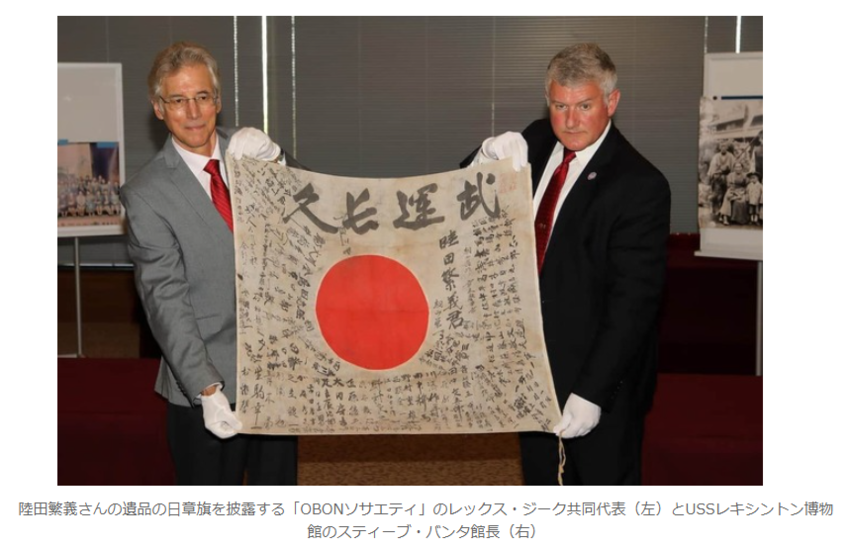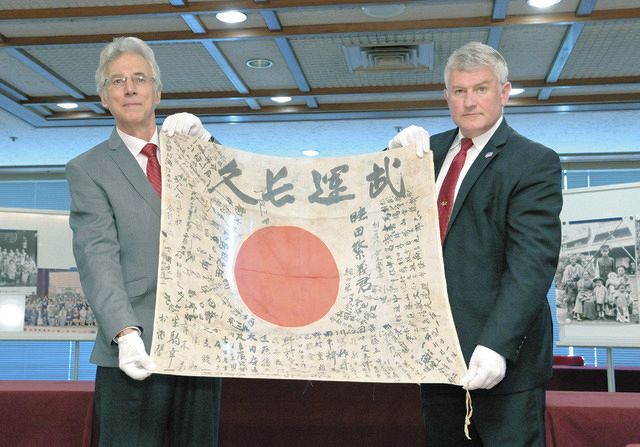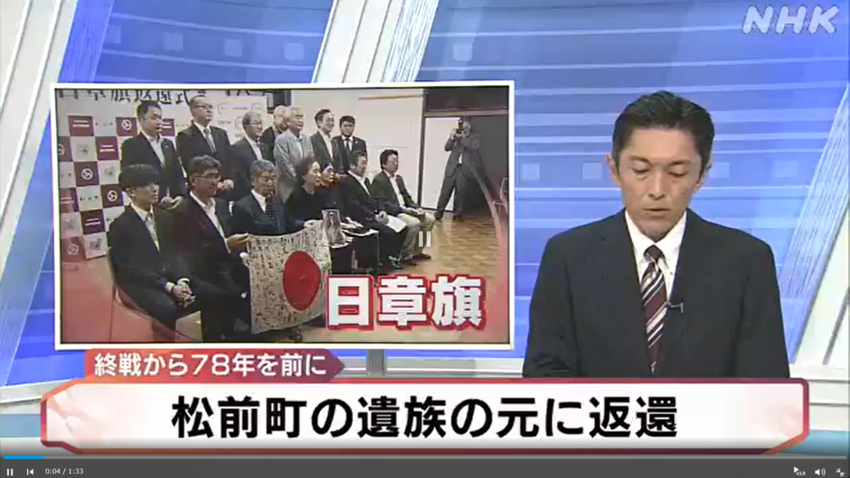- Hashtag "#soldier" returned 157 results.
 USS Lexington Museum executive director Steve Banta, left, and Toshihiro Mutsuda, the elderly son of Japanese soldier Shigeyoshi Mutsuda, hold together Mutsuda's good luck flag during the handover cer
USS Lexington Museum executive director Steve Banta, left, and Toshihiro Mutsuda, the elderly son of Japanese soldier Shigeyoshi Mutsuda, hold together Mutsuda's good luck flag during the handover cer
USS Lexington Museum executive director Steve Banta, left, and Toshihiro Mutsuda, the elderly son of Japanese soldier Shigeyoshi Mutsuda, hold together Mutsuda's good luck flag during the handover ceremony of his good luck flag at Yasukuni shrine in Tokyo, Japan, on July 29, 2023. (AP Photo/Shuji Kajiyama)
USS Lexington Museum executive director Steve Banta, left, and Toshihiro Mutsuda, the elderly son of Japanese soldier Shigeyoshi Mutsuda, hold together Mutsuda's good luck flag during the handover ceremony of his good luck flag at Yasukuni shrine in Tokyo, Japan, on July 29, 2023. (AP Photo/Shuji Kajiyama)
TOKYO (AP) -- Toshihiro Mutsuda was only 5 years old when he last saw his father, who was drafted by Japan's Imperial Army in 1943 and killed in action. For him, his father was a bespectacled man in an old family photo standing by a signed good-luck flag that he carried to war.
On Saturday, when the flag was returned to him from a U.S. war museum where it had been on display for 29 years, Mutsuda, now 83, said: "It's a miracle."
The flag, known as "Yosegaki Hinomaru," or Good Luck Flag, carries the soldier's name, Shigeyoshi Mutsuda, and the signatures of his relatives, friends and neighbors wishing him luck. It was given to him before he was drafted by the Army. His family was later told he died in Saipan, but his remains were never returned.
The flag was donated in 1994 and displayed at the museum aboard the USS Lexington, a WWII aircraft carrier, in Corpus Christi, Texas. Its meaning was not known until it was identified by the family earlier this year, said museum director Steve Banta, who brought the flag to Tokyo.
Banta said he learned the story behind the flag earlier this year when he was contacted by the Obon Society, a nonprofit organization that has returned about 500 similar flags as non-biological remains, to the descendants of Japanese servicemembers killed in the war.
The search for the flag's original owner started in April when a museum visitor took a photo and asked an expert about the description that it had belonged to a "kamikaze" suicide pilot. When Shigeyoshi Mutsuda's grandson saw the photo, he sought help from the Obon Society, group co-founder Keiko Ziak said.
"When we learned all of this, and that the family would like to have the flag, we knew immediately that the flag did not belong to us," Banta said at the handover ceremony. "We knew that the right thing to do would be to send the flag home, to be in Japan and to the family."
The soldier's eldest son, Toshihiro Mutsuda, was speechless for a few seconds when Banta, wearing white gloves, gently placed the neatly folded flag into his hands. Two of his younger siblings, both in their 80s, stood by and looked on silently. The three children, all wearing cotton gloves so they wouldn't damage the decades-old flag, carefully unfolded it to show to the audience.
"After receiving the flag today, I earnestly felt that the war like that should never be fought again and that I do not wish anyone else to go through this sadness (of separation)," Toshihiro Mutsuda said.
The soldier's daughter, Misako Matsukuchi, touched the flag with both hands and prayed. "After nearly 80 years, the spirit of our father returned to us. I hope he can finally rest in peace," Matsukuchi said later.
Toshihiro Mutsuda said his memory of his father was foggy. However, he clearly remembers his mother, Masae Mutsuda, who died five years ago at age 102, used to make the long-distance bus trip almost every year from the farming town in Gifu, central Japan, to Tokyo's Yasukuni Shrine, where the 2.5 million war dead are enshrined, to pay tribute to her husband's spirit.
The shrine is controversial, as it includes convicted war criminals among those commemorated. Victims of Japanese aggression during the first half of the 20th century, especially China and the Koreas, see Yasukuni as a symbol of Japanese militarism. However, for the Mutsuda family, it's a place to remember the loss of a father and husband.
"It's like an old love story across the ages coming together ... It doesn't matter where," Banta said, referring to the Yasukuni controversy. "The important thing is this flag goes to the family."
That's why Toshihiro Mutsuda and his siblings chose to receive the flag at Yasukuni and brought the framed photos of their parents.
"My mother missed him and wanted to see him so much and that's why she used to pray here," he said. "Today her wish finally came true, and she was able to be reunited."
Keeping the flag on his lap, he said, "I feel the weight of the flag."
https://mainichi.jp/english/articles/20230730/p2g/00m/0na/011000c?fbclid=IwAR3LnJfdvxET2Q9I-kGojmJVVh83SFhL_P-J-Jfrvdbm2Y_vR-TlxzQ1h_Q

![【The Associated...]()
TOKYO — Toshihiro Mutsuda was only 5 years old when he last saw his father, who was drafted by Japan's Imperial Army in 1943 and killed in action. For him, his father was a bespectacled man in an old family photo standing by a signed good-luck flag that he carried to war.
On Saturday, when the flag was returned to him from a U.S. war museum where it had been on display for 29 years, Mutsuda, now 83, said: "It's a miracle."
The flag, known as "Yosegaki Hinomaru," or Good Luck Flag, carries the soldier's name, Shigeyoshi Mutsuda, and the signatures of his relatives, friends and neighbors wishing him luck. It was given to him before he was drafted by the Army. His family was later told he died in Saipan, but his remains were never returned.
The flag was donated in 1994 and displayed at the museum aboard the USS Lexington, a WWII aircraft carrier, in Corpus Christi, Texas. Its meaning was not known until it was identified by the family earlier this year, said the museum director Steve Banta, who brought the flag to Tokyo.
https://www.npr.org/2023/07/29/1190933123/japan-soldier-flag-world-war-ii-returned?fbclid=IwAR0BtR0oSZ0CavhzBWYxUqpZabus6FQsEwzpVWZKi-OT27ogdlujiIl1VH8
![USSレキシントン博物館に展示...]() USSレキシントン博物館に展示されていた日章旗を見せる、同館のスティーブ・バンタ館長(右)と、遺族への返還の橋渡しを務めるNPO「OBONソサエティ」のレックス・ジーク共同代表=東京都千代田区の日本記者クラブで
USSレキシントン博物館に展示されていた日章旗を見せる、同館のスティーブ・バンタ館長(右)と、遺族への返還の橋渡しを務めるNPO「OBONソサエティ」のレックス・ジーク共同代表=東京都千代田区の日本記者クラブで
東京都千代田区の日本記者クラブで27日、これまで600枚近い日章旗を遺族に返還してきた米西部オレゴン州のNPO「OBON(オボン)ソサエティ」と、退役空母を改装して太平洋戦争にまつわる品などを展示する米南部テキサス州の「USSレキシントン博物館」の関係者が記者会見を開き、返還を明らかにした。
博物館によると、日章旗は開館2年後の1994年から額縁に入れて展示しており、入手経緯は不明。敏弘さんによると、博物館で日章旗を見かけた人が写真を撮影、専門家の分析を経て父・繁義さんの遺品ではと連絡があったという。
敏弘さんから今年4月、出征前の繁義さんと署名入り日章旗を写した写真などを受け取ったオボンソサエティが、博物館に協力を依頼。博物館が日章旗を額縁から出し、文字の見え方を確認したところ「完全に一致」し、返還を決めた。
◆「旗の意味を知り、私たちの手元にあるべきでないと理解した」
会見したスティーブ・バンタ館長は「(展示していた)29年間、旗に込められた意味が分からなかった。その意味や家族が返還を希望していると知り、私たちの手元にあるべきでないと理解した。あるべき場所に返すことができ、光栄に思う。返還を通じ、日米の平和友好関係を促進できることを願っている」と話した。
敏弘さんは「父が出征したのは、私が4歳くらいの時。父の印象はあまり残っておらず、日章旗があることは知らなかった。旗が残っていたこと自体奇跡で、父の帰りたいという願いがずっとあったのだろう」と話した。
https://www.tokyo-np.co.jp/article/265938?fbclid=IwAR0BsN9PC3Ik9aTNljS_amxwcDS9xKG-kPC0-vINyhKZ9J40nAg5fSMe3vs
【松前】太平洋戦争末期に多くの住民を巻き込んだ1945年(昭和20年)の沖縄戦で戦死した鈴木秀二さん(享年38)が戦地で持っていた日章旗が、戦後78年を前に町内在住の遺族の元に返還された。旧日本兵の遺品返還に取り組む米国のNPO法人「OBONソサエティ」の仲介で実現した。長男の一弘さん(86)は「父親の形見がひとつもなかった。うれしい」と話した。
同団体や遺族によると、秀二さんは留萌市出身。旧陸軍第24師団輜重兵(しちょうへい)として、武器や弾薬などの運搬を担当していたという。旧日本軍が組織的な戦闘を終えたとされる6月23日の2日前の21日に死亡した。最期の様子は分かっていない。
今月26日に町役場で行われた返還式には、遺族7人が出席した。一弘さんと妻の玲子さん(83)が石山英雄町長から日章旗を受け取った。縦約65センチ、横約80センチの旗には「必勝」「大和心」などの寄せ書きが記され、出征時に渡されたとみられる。一弘さんは「優しい父だった」と在りし日の姿に思いをはせ、玲子さんも「夢のよう」と涙ぐんだ。日章旗は自宅の仏壇に供えるという。
日章旗は、沖縄戦に参戦した元米国陸軍大佐が持ち帰った。その後、孫が旗に込められた思いを知り、2020年に同団体に返還を依頼した。直後に連絡を受けた札幌在住の同団体スタッフの工藤公督さん(48)が留萌市内などで調査を開始。60年ほど前に松前町の企業に就職し、現在も町内で暮らす一弘さんの存在を知り、1カ月ほど前に連絡した。
一弘さんは小学校入学前に秀二さんと別れ、「連絡が来た時はびっくりした。工藤さんや団体には感謝しかない」と話した。
https://www.hokkaido-np.co.jp/article/884427
【松前】第2次世界大戦末期の1945(昭和20)年6月に沖縄戦で亡くなった留萌市出身の陸軍兵士、鈴木秀二(ひでじ)さん(当時37歳)の日章旗が26日、米オレゴン州のNPO法人「OBONソサエティ」を通じて松前町在住の遺族に返還された。日章旗は米国の元兵士が長年保管していて、78年の年月を経て長男の鈴木一弘さん(86)の手に渡った。一弘さんは「ありがたい。うれしい」と喜んだ。
同法人によると、秀二さんは日本陸軍第24師団に所属し、食料や武器の輸送などを担う輜重(しちょう)兵第24連隊第五中隊の伍長だった。激戦地だった沖縄本島の糸満市真栄平(まえひら)で、6月21日に亡くなった。
秀二さんの日章旗は米国の元陸軍大佐、エイドリアン・リンジー氏(故人)が戦場から持ち帰り、長年保管していた。リンジー氏が他界した後は孫のジョージ・ヘルムスタッター氏(アイダホ州在住)が受け継ぎ、2020年9月に同法人に所有者、遺族の捜索と返還を依頼していた。
遺族探しを担当したのは、同法人スタッフで、札幌在住の工藤公督さん(48)。日章旗に「留萌土木現業所 鈴木秀二君」などと書かれていたことや、日本遺族会の情報などから秀二さんが留萌市礼受(れうけ)出身と特定。工藤さんはさらに礼受の地域住民などから鈴木家の足跡を尋ね、松前町の一弘さんを探し出した。
26日は松前町役場で返還式が行われ、一弘さんら遺族7人が出席。一弘さんは石山英雄町長から日章旗を受け取り感慨深げに旗を見つめた。同法人共同代表のレックス・ジーク氏、敬子・ジーク氏のメッセージが動画で紹介されたほか、石山町長も「故人の家族への思いと関係各位の平和と友好を思う気持ちが実を結んだ。町としても平和の尊さを次世代につないでいく」と述べた。
秀二さんが出征時、一弘さんは小学校入学前だったが「父はマージャンが好きだった。温厚で優しかった」と懐かしみ、「連絡を受けた時はドキドキした。感謝の気落ちでいっぱい」と話した。一弘さんの次男、修二さん(50)は「日章旗が戻ってくるとは思ってなかった。祖父が眠る沖縄にお参りしたい」と話した。
https://hokkaido-nl.jp/article/30215
7月26日、午前11時から約30分間、山田賢司外務副大臣は、旧日本兵の「寄せ書き日の丸」を始めとする戦時遺留品の返還活動を行っている、レックス・ジーク及び敬子・ジークOBON SOCIETY共同代表(Rex and Keiko Ziak, co-founders of OBON SOCIETY)、スティーブ・バンタUSS Lexington博物館館長(Steve Banta, Executive Director of USS Lexington Museum)他の表敬を受けたところ、概要は以下のとおりです。
レックス・ジーク氏及び敬子・ジーク氏、またスティーブ・バンタUSS Lexington博物館館長から、日章旗の返還や最近のOBON SOCIETYによる戦時遺留品返還活動等について説明がありました。
これに対し、山田副大臣から、日米の友情と絆を強固にするOBON SOCIETYの活動は大変貴重なものであり、同団体の引き続きの御活躍を期待したい旨述べました。また、日章旗の返還にあたり、USS Lexington博物館の協力に謝意を表しました。
(参考)OBON SOCIETY 米国オレゴン州を中心に活動する非営利団体。主に第二次世界大戦時に連合軍兵士が戦場から持ち帰った「寄せ書き日の丸(日章旗)」を始めとする日本兵の遺留品を日本の遺族の元へ返還する活動を行っており、日本遺族会からも委託を受けている。平成27年外務大臣表彰を受賞。
太平洋戦争の沖縄戦で戦死した留萌市出身の男性の日章旗が、終戦から78年となるのを前に、道南の松前町に住む遺族の元に返還されました。
返還された日章旗は、昭和20年6月に太平洋戦争の沖縄戦に従軍し、38歳で戦死した留萌市出身の旧日本陸軍の軍人、鈴木秀二さんが所持していたものです。
松前町役場で行われた返還式には、鈴木秀二さんの長男の鈴木一弘さん(86)ら遺族が出席し、石山英雄町長から日章旗を受け取りました。
日章旗には秀二さんの名前とともに、「必勝」などの文字が寄せ書きされていて、手に取った遺族は時折涙を浮かべ生前の記憶に思いをはせていました。
日章旗は沖縄戦に参戦したアメリカ陸軍の元軍人が戦地から持ち帰っていましたが、その孫が、戦没者の遺留品を遺族の元に返す活動をしているアメリカのNPO「OBONソサエティ」に依頼し、遺族を探し出したということです。
一弘さんの妻の鈴木玲子さんは「夢のようです」と話していました。
https://www3.nhk.or.jp/sapporo-news/20230726/7000059478.html?fbclid=IwAR19sUCjzSPPEUdxhjpp53TFkwSzhUqOZU6iLE0lTM9C9IZiwdQxrT2sylI
We are off to Japan now! Getting ready for our big event with USS Lexington staff!
いよいよレキシントン博物館に展示されていた日章旗を持参して日本へ向かいます!
無事にご遺族へお返しできますように-
- If you are a bloguru member, please login.
Login
- If you are not a bloguru member, you may request a free account here:
Request Account
 USS Lexington Museum executive director Steve Banta, left, and Toshihiro Mutsuda, the elderly son of Japanese soldier Shigeyoshi Mutsuda, hold together Mutsuda's good luck flag during the handover cer
USS Lexington Museum executive director Steve Banta, left, and Toshihiro Mutsuda, the elderly son of Japanese soldier Shigeyoshi Mutsuda, hold together Mutsuda's good luck flag during the handover cer














